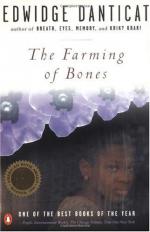|
This section contains 394 words (approx. 1 page at 400 words per page) |

|
The Farming of Bones Summary & Study Guide Description
The Farming of Bones Summary & Study Guide includes comprehensive information and analysis to help you understand the book. This study guide contains the following sections:
This detailed literature summary also contains Bibliography and a Free Quiz on The Farming of Bones by Edwidge Danticat.
The Farming of Bones, Danticat told Megan Rooney in The Brown Daily Herald, is a survivor's story, based on the true story of a woman who was killed in the massacre. "But I wanted her to live," Danticat says, and in the book, she does. The book, which has received almost universally favorable reviews, is based on historical facts, filtered through Haitian tales and oral history, "a collage of various characters and experiences from my upbringing in Haiti," she told Rooney.
Although Danticat was still in her twenties when her first book, Breath, Eyes, Memory, was published, it received critical acclaim and was selected for Oprah Winfrey's book club, rocketing it to the top of the bestseller lists and commercial success. This success eventually led Penguin to pay $200,000 for the paperback rights to The Farming of Bones.
Danticat spent several years researching the events in The Farming of Bones, traveling to Haiti as many as four times a year. After visiting the Massacre River there in 1995, she realized that she wanted to write a book about the 1937 massacre of Haitians by Dominican dictator Rafael Trujillo. When she visited, there was no sign of the mass killings that occurred so many decades ago: a woman was washing clothes in the water, a man was letting a mule drink, and two boys were bathing. The river itself was small and slow, nowhere near the high-water mark that once swallowed hundreds of bodies. "I had come looking for deaths," she wrote in Kreyol, "but I found habitualness, routine, life."
Despite this peace, or perhaps because of it because the event and the people who suffered in it seemed to have been lost and forgottenshe decided to memorialize them by writing the book. "I felt like I was standing on top of a huge mass grave, and just couldn't see the bodies," she told Mallay Charters in Publishers Weekly, and reflected, "It's part of our history as Haitians, but it's also a part of the history of the world. Writing about it is an act of remembrance."
Danticat does not merely write about Haiti, but is still active in the Haitian community. With writer Junot Diaz, she runs Haitian-Dominican youth groups in New York, and also works with the National Coalition for Human Rights as part of a grant from the Lila Wallace-Readers Digest Foundation.
Read more from the Study Guide
|
This section contains 394 words (approx. 1 page at 400 words per page) |

|



